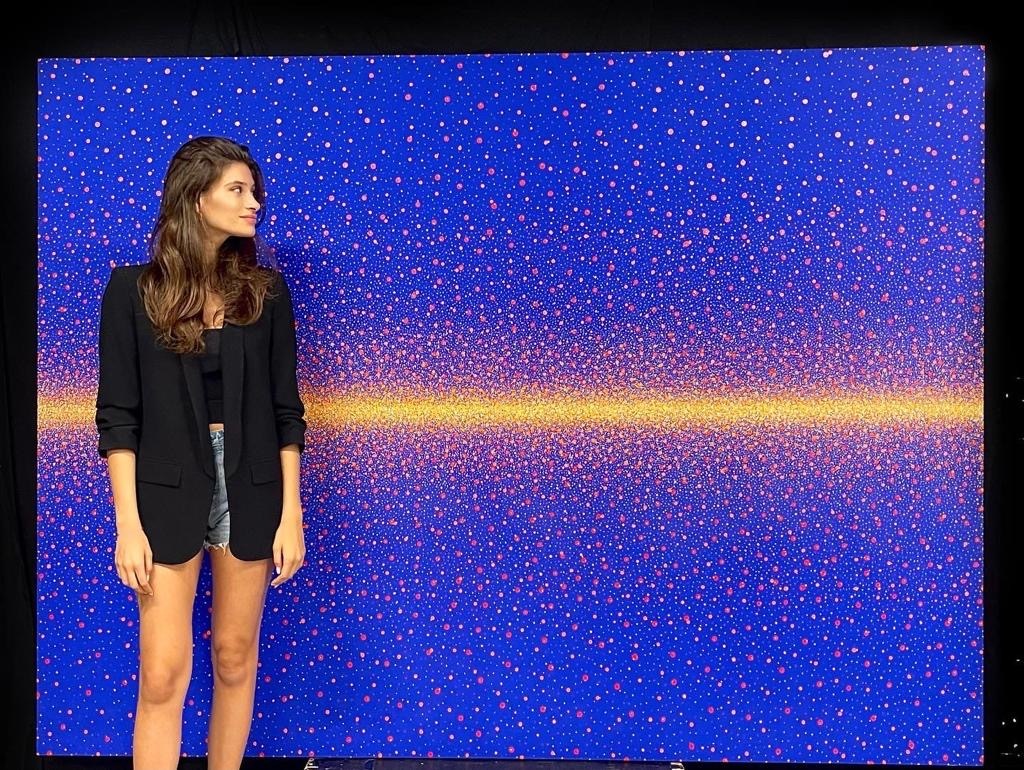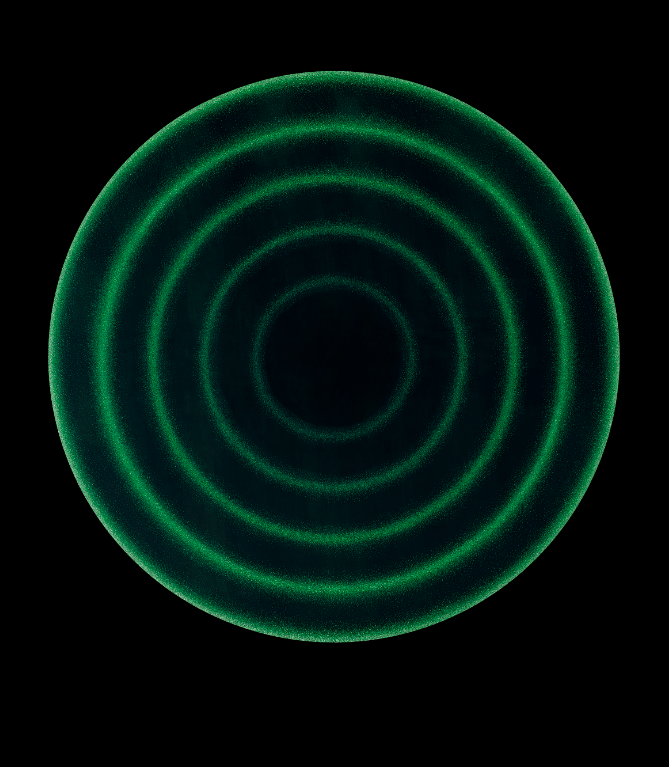
Cairo, tell me, how did you get into art initially?
I loved art as a kid, it was always my favourite subject in school and my greatest passion. In my final years of high school, my art teacher really pushed me to make these figurative pieces based on some of the difficult times I was going through in my personal life. It became very cathartic for me to express myself through my art. When I started modelling, I continued to make works based off of my experiences and really specifically focused on how the standard of beauty and the harsh expectations in the industry were affecting me. I was focusing on how being in that industry was damaging to me and I used art as an outlet for that.
Did the lockdowns have an affect on your art career?
I really wanted to go back to school and get my degree in fine art, especially because I was feeling more fulfilled through the artwork I was creating than I was by my modelling career. In lockdown, with so little to do during the day, I really dedicated most of my days to drawing. It was the first time I could do what I truly loved without any distractions. I began to have the belief in myself that I could turn my passion into my career. I think that’s when I really decided I’m not going to go back to modelling, because I noticed I was suddenly a lot happier focusing on my art.
When I started my degree at Goldsmith’s in 2020, I challenged myself to experiment with different styles and mediums. Through trial and error I coupled my love for abstraction with pointillism. I really wanted to try something completely different. I wanted to paint like I’ve never painted before, so I embarked on this whole new style.

Speaking of your new style, talk me through this transition and the impact you think it’s made?
I’ve always loved creating works that involved a lot of labour and detail. The art pieces I did before Goldsmiths were quite laborious because I wanted to make them very realistic. When I started university and changed my style, I diverted from narrative based works to works based off of optical illusions, colour theory and abstraction because, aesthetically, I was more drawn to bold colours. I wanted to experiment with pointillism because I used to make pointillist doodles all over my notebooks. I started to wonder how I could bring my doodles to a larger scale and committed to the hours it would take to create the works I was imagining.
Your pieces look like they take a massive amount of work just preparing it…
I have to rely on mathematics to create precision and symmetry in my works. Before I begin painting, I map out the canvas with precise markers to guide me in executing the design. To place the markers I either have to trace projections or have to measure everything by hand. This process usually takes me about ten hours, but it’s integral to the works and enables me to find the painting stage very meditative as it’s like colouring inside the lines.
My process is that I cover the canvas first in a certain colour, and then, because I’m very mathematical, I map out the piece with water soluble pencils and measure everything. I sometimes use projectors to get certain lines spot on. After mapping it, though, the rest of it is really meditative, because by then I have all the markers. Throughout the painting stage I feel very much in control because I have a methodical process to create the effect of gradients, depth and luminosity. I know what I’m doing. I feel very much in control.
View this post on Instagram
I think my pieces are a total fixation of detail. Hour by hour the piece comes together with layered, tiny dots. I often get asked, ‘Why couldn’t I make this digitally?’ But, for me, really the most important part of all these works is that it’s a painting; that my works are paintings and the viewer can see this the overwhelming amount of detail and labour that goes into each piece. And that I want this to kind of evokes a sense of madness so someone can question 'what crazy person would map this out would sit and paint each of these dots?’
The scale of your paintings has increased exponentially, how did that come about?
I think I’m getting more and more ambitious. And also more confident in my ability. When a huge canvas arrives, it can be a little overwhelming, but I just tackle it bit by bit. I have to be very patient because even in a week’s time, I don’t see much progress. With the big pieces, it’s more about being patient and trusting myself and trusting the mathematics and the planning that I’ve done beforehand with research.
With the canvases getting larger, I’ve been really interested in creating this juxtaposition of scale. I want to give the viewer a different experience when standing away from each piece versus when up close. From afar, the works have a geometric design that give off the illusion of either depth or of luminosity. Yet, when one observes the works from up close, they experience the form dissolving into tiny dots similar to pixels that make up images on a screen.


I find satisfaction in how the works change based off of one’s visual perspective. Being able to stand back and look at the piece and appreciate maybe the design or the optical illusion, but then when you get closer, the viewer has a different experience in that they really then see the detail and labour of it. I like that you’re changing your perspective.
How do you stay focused on your art, when you’ve got so much going on outside of it?
Throughout high school, I had ADHD, but the type of ADHD where I would fall asleep in class; I can’t concentrate on anything that doesn’t interest me but when I am interested in something I become hyper focused. This intense ability to focus allows me to lose track of time and paint up to ten hours a day.
I have the same ability to focus on piano. I can sit and practice a song for four hours straight. It’s just the same with painting. It’s a skill that helps me greatly and that I’m very thankful to have… though it didn’t come in handy when falling asleep in history class at school.
View this post on Instagram
How does it feel having such great feedback from galleries?
It’s been so fulfilling. It’s just been truly the most exciting thing that’s ever happened to me. I honestly feel so incredibly grateful that people are responding to the work so well and getting excited about it. I couldn’t have dreamed of it. I think initially I was a bit nervous to put it all out there, because you never know how people are going to react. And now the eagerness to share my work is a big part of my motivation.
I just get really excited about sharing. I’m meeting with people at times who are so much more knowledgeable than I am about art and everything. I’ve had the opportunity to meet with experts in the field who’s knowledge and perspectives inspire me and encourage me to push myself. My tutors, different gallerists, and collectors have helped me delve into the meaning of my work and create a context for my pieces to sit in. And their perspectives also really inform what I’m doing and give me a deeper understanding of my work too. They talk about the context that the piece maybe sits in or which artists it reminds them of.
And finally, we have your first solo exhibition coming up. Tell me how the preparations for that are going?
I couldn’t be more excited. I feel honoured to have Isabel Getty curating the show and working alongside me. All the works are centred around the concept of time and the colour palette chosen for this series alludes to astrological phenomena. As I started this series, I was inspired by the many mathematical and visual patterns of eclipses, black holes, differing orbits and the golden ratio of our galaxy.
These marvels of astronomy have greatly influenced the works in the show. I was also inspired by artists like James Turell, Yaiko Kusama and digital artist Refik Anadol who evoke the sublime in their installations. I will have seven large pieces on display along with six smaller pieces. I am currently completing final touches.


